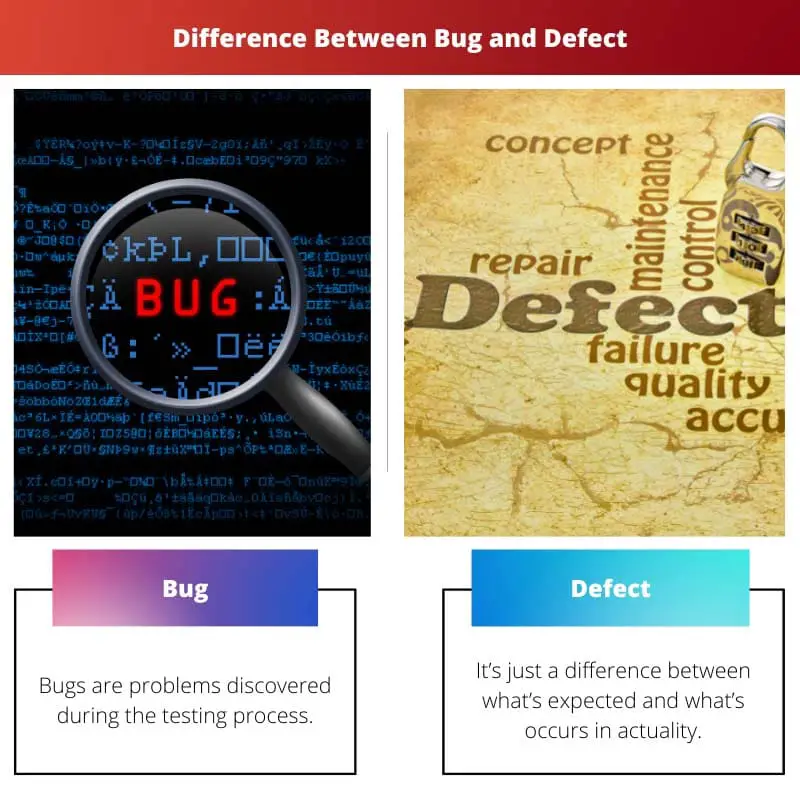Software testing is the process of determining the correctness, completeness, and quality of generated software. It entails identifying flaws in the product that must be addressed before it is delivered to the public.
Testing aids in the creation of high-quality software as a final product. A fault or flaw in the software might occur throughout the development process.
A defect is a divergence from the original output need, whereas a bug is a programming error.
Key Takeaways
- A bug is a coding error in a software program that causes unexpected results, while a defect is a flaw in the software’s functionality or design.
- A bug can be fixed without affecting the program’s overall performance, while a defect requires a more significant overhaul.
- A bug is easier to fix than a defect because it is a specific coding issue, whereas a defect can be more complex and difficult to identify.
Bug vs Defect
The term bug is used to refer to a problem when the software behaves in a way that is not intended or expected. The defect is a problem affecting the software’s performance, usability, or reliability. A defect could be due to a software design problem.

A mistake, defect, or flaw in a computer software or hardware system is a bug. A bug causes a plan to act unexpectedly or deliver unexpected outcomes.
In a nutshell, it’s any action or outcome a software or system produces that it was not intended to do.
A defect is a mistake discovered after the application has gone live. It refers to various issues with software products, such as their exterior behaviour or internal features.
In other words, in the testing context, a Defect is a divergence between predicted and actual outcomes. It’s when a customer’s criteria aren’t met.
Comparison Table
| Parameters of Comparison | Bug | Defect |
|---|---|---|
| Definition | Bugs are problems discovered during the testing process. | Operational development methodologies and assessing the code regularly. |
| Raised by | Test engineers. | Testers. |
| Types | Logic, algorithmic, and resource bugs. | Critical, major, minor, and trivial. |
| Reasons for occurring | Missing code, incorrect coding, or extra coding. | A coding or logic fault and wrong input. |
| Prevention | We are utilizing fundamental and precise software development approaches. | Utilizing fundamental and precise software development approaches. |
What is Bug?
The bug is essentially a mistake that occurs throughout the software development life cycle.
Every problem damages the functionality in which it occurs and can potentially spread to other parts of the program. When fixing a bug, this ripple effect must be considered.
Lack of foresight in predicting such situations might result in significant complications and a rise in bugs.
There are several methods for reducing the number of bugs. There are a variety of programming styles and defensive programming techniques that can help in finding issues quickly.
Bug-prevention mechanisms are built into programming languages. Some of them are restricted namespaces, modular programming, and so on.
Furthermore, there are code analysis tools that allow developers to study a program beyond the compiler’s capacity to find a fault. Debugging is the process of repairing bugs.
Debuggers are special tools that assist programmers in uncovering faults by executing the code line by line. It provides for observing program activity by monitoring variable values and other aspects.
In software testing, a bug report is a thorough document describing the issues discovered in the software program.
The bug report includes information such as the bug’s description, the date it was discovered, the tester who found it, the developer who corrected it, and so on. Bug reports assist in identifying and avoiding similar issues in the future.

What is Defect?
A defect is an inaccuracy in the system that prevents the planned activity from being carried out. The most important job of a tester is to find flaws.
Because faults can be detected at any point throughout the software development process, it’s critical to begin testing as soon as feasible. The sooner we recognize problems, the less expensive it will be to correct them.
Testers may come upon such issues when carrying out test cases. Using a defect management approach to handle defects is an excellent way to go.
First, faults are found as much as feasible during the discovery phase. The categorizing stage is the next step.
It entails categorizing flaws into high, medium, and low-priority categories. As a result, it is easier to determine which weaknesses should be addressed immediately.
Resolution is the third phase. At this point, actions are taken to correct the problem. Verification is the fourth phase. It guarantees that the flaws are genuinely fixed.
Closure, the fifth phase, transforms the status of a detect to “closed.” If this is not the case, efforts are made to re-examine the fault.
The last process is reporting, which entails disclosing the fault and receiving comments from management.
Main Differences Between Bugs and Defects
- A bug is caused by a code mistake. The defect is the discrepancy between the actual results and intended outputs discovered in the development environment before the product is sent to the client.
- The test engineers submit the bug, and the testers identify the defect. In addition, the developer solved it throughout the development period or stage.
- Different types of bugs include logic, algorithmic, and resource bugs, whereas different types of defects include critical, major, minor, and trivial based on severity.
- Bugs can be caused by missing code, incorrect coding, or extra coding, whereas providing inaccurate and erroneous inputs or coding or logic fault impacts the program and causes it to break down or fail, which leads to defects.
- Bugs may be avoided by adjusting, advanced, and operational development techniques, as well as routinely evaluating the code whereas Implementing numerous novel programming approaches, using primary and accurate software development methodologies, and using peer review to conduct consistent code reviews to assess its quality and accuracy might help to avoid defects.

- https://ieeexplore.ieee.org/abstract/document/6693087/
- https://ieeexplore.ieee.org/abstract/document/5645567

The comparison table is an excellent way to showcase the differences between bugs and defects. It’s such a critical aspect of software development and the table does a fantastic job of summarizing it.
This article seems to be very insightful, especially in terms of understanding the depth of the bug and defect, and how it affects the overall software development process. This concept will help many new software developers.
The article is very insightful, and the comparison between bugs and defects is quite clear. The examples and explanations provided are commendable.
I have learned so much from this article. The distinction between a bug and a defect is quite clear now, showing the significance of precision in software development.
The article is too verbose. It could be more concise to keep the reader engaged. It feels like overloading with a lot of information.
The post does a great job at explaining the concept of software testing and distinguishing between bugs and defects. It’s a very informative content and very well-written.